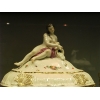|
 Figurines of
various sizes made from different material are popular throughout centuries, back
from the times immemorial. The figurines were made previously from bones, wood,
stone and clay later metal was used to make the miniature figurines and
sculpture groups. Previously the figurines were made not only for the purposes
to honor gods and spirits being the religious symbols and cult items, but also
charming accessories that urged to adorn the severe house holding. The first porcelain
figurines were created in China,
the motherland of china. As soon as the tiny delicate items arrived to Europe, they seized the hearts of china admirers. The china
was considered as the «white gold», it was estimated at the level of the precious
metal, and the porcelain figurines became the symbol of authority and wealth,
the image accessory for the design of premise and the indicator of the status. Figurines of
various sizes made from different material are popular throughout centuries, back
from the times immemorial. The figurines were made previously from bones, wood,
stone and clay later metal was used to make the miniature figurines and
sculpture groups. Previously the figurines were made not only for the purposes
to honor gods and spirits being the religious symbols and cult items, but also
charming accessories that urged to adorn the severe house holding. The first porcelain
figurines were created in China,
the motherland of china. As soon as the tiny delicate items arrived to Europe, they seized the hearts of china admirers. The china
was considered as the «white gold», it was estimated at the level of the precious
metal, and the porcelain figurines became the symbol of authority and wealth,
the image accessory for the design of premise and the indicator of the status.
Porcelain figurines
were the luxury items to afford by the wealthy and ordinary people could only
dream of acquiring them. The native fineness of porcelain figurine made them favorable
among the public and till now china attracts the collectors and amateurs of art
works.
The beauty,
elegance and delicacy of porcelain figurines make them attractive for china
collectors. The variety of themes for porcelain figurines, the painting, the evolution
of figurines and the tiny sizes make them popular and prestigious o pick up and
enjoy. It is beyond doubt, collecting of sculptures and statues is far more esteemed
to collect, though this activity requires the castle with the park adjoined to
it, and the collection of figurine requires a plain glass cupboard. The beauty of
porcelain figurines is much more alive and vital than the solemn pompousness of
marble items.
In 1709 Europe revealed the secret of china production and the
real boom of porcelain figurine occurred. At the early stages of china
production, the figurine of European masters were strongly attracted by the
Chinese and Japanese standards, though to the middle of the XVIII century the
unique classic style of European porcelain figurine was founded. The samples
for porcelain compositions were the works by the reputed painters, namely Jean
Antoine Watteau, Jean-Baptiste Simon Chardin, François Boucher and others. Dancers
and ballerinas, theater performers, ladies and cavaliers, musicians and acrobats
are all personified in the painted porcelain.
The Meissen
Porcelain Manufacture was the establishment that promoted the development of
fashion for porcelain figurines. Johann Joachim Kändler, the reputed designer
of the manufacture created the rococo style and the charming figurines were
found to be the accessories for ladies’ boudoirs, the tables were served in
china and picked up by collectors. The Meissen Porcelain Manufacture launched the
dinner services with porcelain figurines, and these figurines were practical in
house holdings to some extent like salt shakers, pepper shakers, bottles for vinegar
and others, though mainly they were assigned to decorate the table.
Thanks to Kändler
the oriental theme finally disappeared from production of European porcelain
figurines. He developed the variety of sculptural series with peasants, shepherds,
hunters, dancers, including the series of love affairs and royal court scenes.
Every theme was rather European without the slightest touch of eastern quetism.
A number of series developed by Kändler outlasted the creator for many centuries
and currently these models are manufactured by the majority of German factories
and china manufacturers in other countries. The themes include the characters of
Italian comedy (every single reputed china manufacturer launched Columbines and
Harlequins, Pierrots and Pierettas), series of «Seasons», «Parts of World», «Four
Elements». The collection of porcelain figurines «Snipe orchestra», created by Kändler
in 1766 is still popular among the china collectors (this collection was
launched by the Meissen Porcelain Manufacture three times and the last time was
done in 50s of XX century).
Along with the
figurines of the Meissen Porcelain Manufacture the figurines in rococo style
were highly evaluated manufactured by the Italian factory Capodimonte which
worked with soft china and bisque. The figurines of actors, shepherds and
citizens, the icons of sacred people and even portray busts were manufactured
by this factory.
France gained the fame for the items of the
прославилась изделиями Sevres Porcelain Manufactory
which produced figurines made by samples of antique memorials, as well as
compositions of the erotic nature. On the top of it, the models of the Sevres
Porcelain Manufactory were made by the famous sculptors as Falcone, Boizot, Clodion
and the painting was made in the style of Boucher and the scenes of the latter
were often used when figurine modeling.
Porcelain
figurine is the good tool to learn the history, especially the history of
fashion, from the fashionable clothes to the fashion for complexion and shapes,
makeup, behavior and style of life.
|